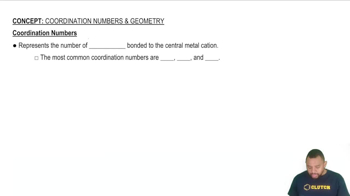Consider the lattice energies of the following Group 2A compounds: BeH2, 3205 kJ/mol; MgH2, 2791 kJ/mol; CaH2, 2410 kJ/mol; SrH2, 2250 kJ/mol; BaH2, 2121 kJ/mol. (c) Consider BeH2. Does it require 3205 kJ of energy to break one mole of the solid into its ions, or does breaking up one mole of solid into its ions release 3205 kJ of energy?
Ch.8 - Basic Concepts of Chemical Bonding
Chapter 8, Problem 82a
The ionic compound CaO crystallizes with the same structure as sodium chloride (Figure 8.3). (a) In this structure, how many O2- are in contact with each Ca2+ ion (Hint: Remember the pattern of ions shown in Figure 8.3 repeats over and over again in all three directions.)
 Verified step by step guidance
Verified step by step guidance1
Identify the crystal structure of sodium chloride (NaCl), which is a face-centered cubic (FCC) lattice.
In the NaCl structure, each sodium ion (Na+) is surrounded by six chloride ions (Cl-), forming an octahedral coordination.
Since CaO crystallizes in the same structure as NaCl, each calcium ion (Ca2+) will also be surrounded by six oxide ions (O2-).
Visualize the repeating pattern in three dimensions, where each Ca2+ ion is at the center of an octahedron formed by O2- ions.
Conclude that in the NaCl-type structure, each Ca2+ ion is in contact with six O2- ions.

Verified video answer for a similar problem:
This video solution was recommended by our tutors as helpful for the problem above.
Video duration:
1mWas this helpful?
Key Concepts
Here are the essential concepts you must grasp in order to answer the question correctly.
Ionic Compounds and Crystal Lattices
Ionic compounds, like CaO, consist of positively and negatively charged ions held together by electrostatic forces. They form a crystal lattice structure, where ions are arranged in a repeating pattern that maximizes attraction and minimizes repulsion. Understanding this arrangement is crucial for determining how many ions of one type are in contact with another in the lattice.
Recommended video:
Guided course

Ionic Compounds Naming
Coordination Number
The coordination number refers to the number of nearest neighbor ions surrounding a central ion in a crystal lattice. In the case of CaO, the coordination number of Ca2+ indicates how many O2- ions are directly adjacent to each calcium ion. This concept is essential for analyzing the spatial arrangement of ions in the crystal structure.
Recommended video:
Guided course

Coordination Numbers
Sodium Chloride Structure
The sodium chloride (NaCl) structure is a common example of a face-centered cubic lattice where each Na+ ion is surrounded by six Cl- ions and vice versa. This arrangement serves as a model for understanding the structure of other ionic compounds, such as CaO, which adopts a similar lattice. Recognizing this similarity helps in visualizing the ion interactions and determining the number of surrounding ions.
Recommended video:
Guided course

Resonance Structures
Related Practice
Textbook Question
Textbook Question
Consider the lattice energies of the following Group 2A compounds: BeH2, 3205 kJ/mol; MgH2, 2791 kJ/mol; CaH2, 2410 kJ/mol; SrH2, 2250 kJ/mol; BaH2, 2121 kJ/mol. (d) The lattice energy of ZnH2 is 2870 kJ/mol. Considering the trend in lattice enthalpies in the Group 2 compounds, predict which Group 2 element is most similar in ionic radius to the Zn2+ ion.
Textbook Question
Construct a Born–Haber cycle for the formation of the hypothetical compound NaCl2, where the sodium ion has a 2+ charge (the second ionization energy for sodium is given in Table 7.2). (a) How large would the lattice energy need to be for the formation of NaCl2 to be exothermic?
